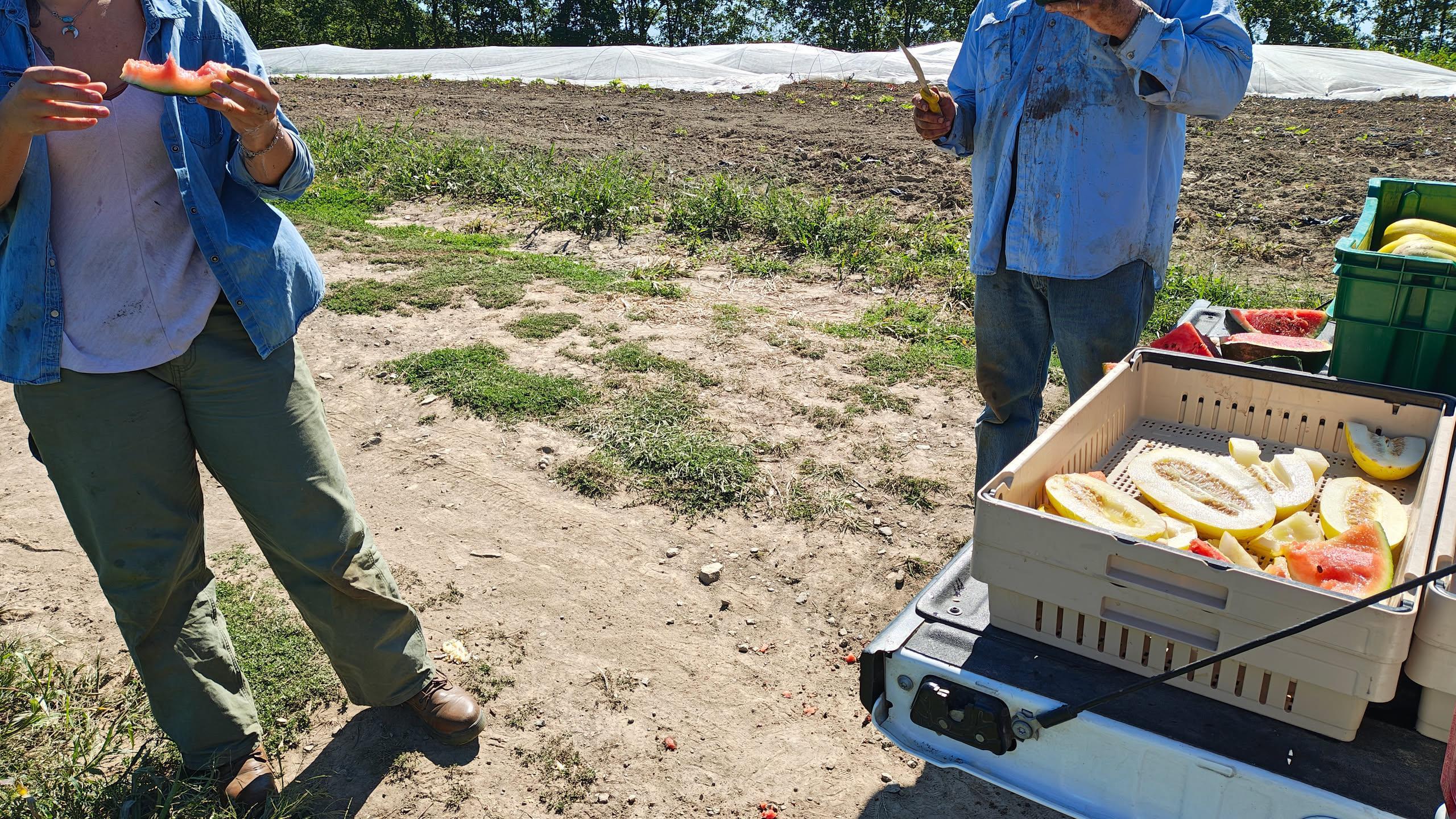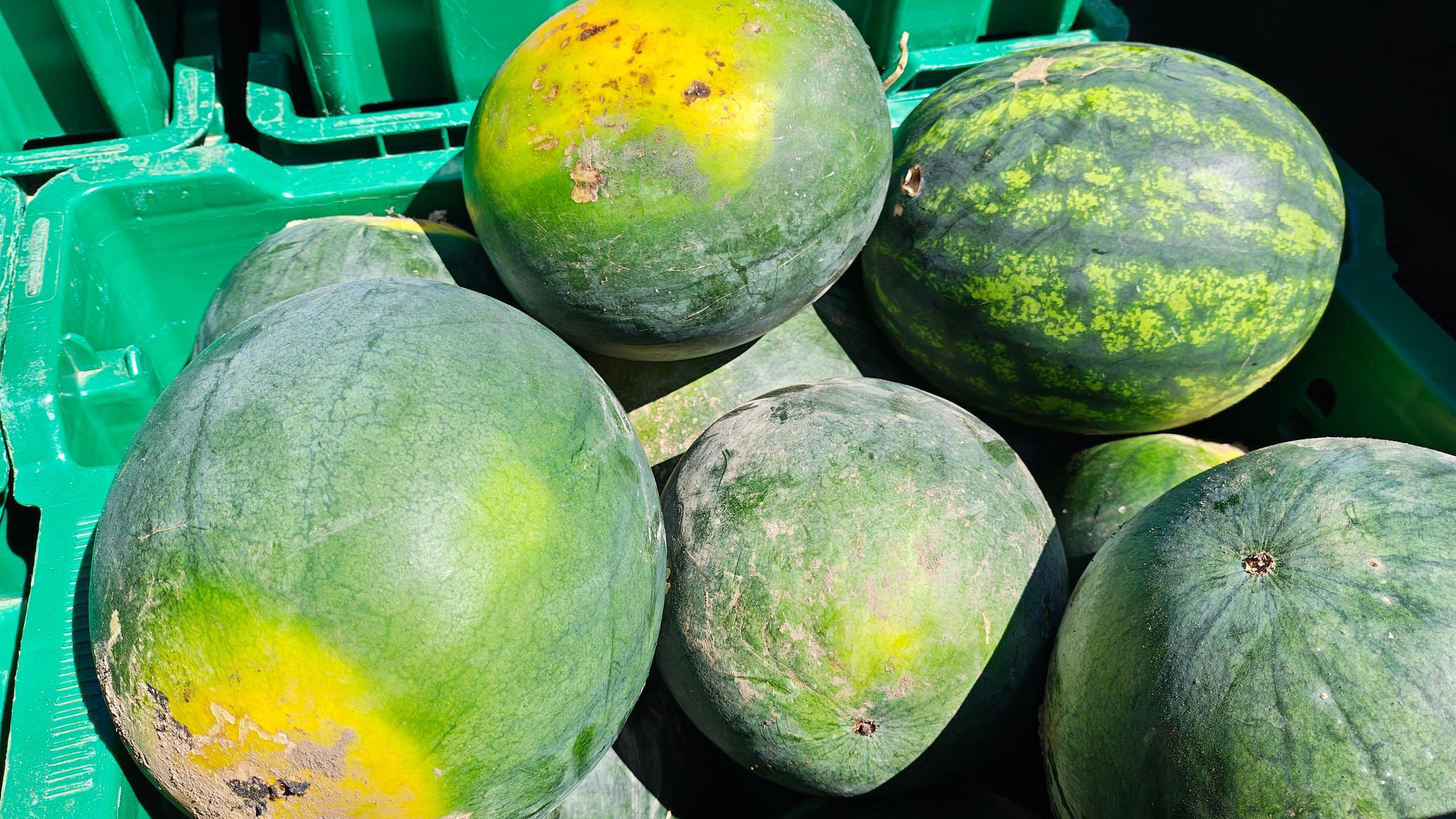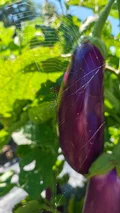TL;DR
We washed bins then harvested eggplants, tomatoes, watermelons, squash, bok choy, and sunflowers. Then we finished hoeing the second of two new carrot patches. It was sunny, breezy, and 70 degrees Fahrenheit, perfect farming weather.
Watermelon Hunting
To tell if it’s time to go hunting, we need to check the field for ripe watermelons about every day or so. This involves finding ones with ripening signs then splitting one or two open and testing them, a nice break from harvesting hundreds of tomatoes. The three varieties we have in the field are ‘JuiceBox’, ‘Sugar Baby’, and ‘Summer Jewel’ (Asian variety).

Despite their bulbous shape, watermelons are elusive prey. They hide amongst the greenery and foliage, making them difficult to spot. They are also incredibly heavy, making them more of an effort to harvest. You should never turn your back on a peak ripe watermelon, as they can turn on you in an instant.
There are a few ways to tell a good melon from a bad one. In the field, there should be a yellow ‘field spot’ on the ‘belly’ (underside) indicating it’s had time on the vine to properly ripen. There is also can be a curly tendril just above where the stem meets the vine which should be dry. When squeezed a bit, a ripe melon will also have just a hint of give.
In the store, you’d want to look for a smooth, even surface with no bruises or dents. It should also be surprisingly heavy for its size, as upwards of 92% of a melon is water. Another way is to tap the melon gently with your knuckles. A good melon will sound hollow when tapped, while a bad one will sound dull.
On a good day, the hunt results in many melons at peak ripeness and ready for refrigeration and sale in a few days, no “cold storage for weeks” silly business.

Hoeing Carrots, Take Two
After the watermelon hunt, we brought them back up to the barn and packed the truck for the Ipswich farmer’s market. Then myself and another team member watered the chickens and the greenhouse nursery flats, and then we started in on hoeing the second row of fall carrots. The first one I finished up yesterday.
Since I do four days on the farm per week and usually leave the fifth free for tech contracting work, Thursday’s are typically by Friday. It was nice to finish the hoeing today and get a break from the toil. We also got rain afterwards, so hopefully that perks up the little carrot sprouts and softens the soil for potential fine-detail hand weeding tomorrow.
Weekend Work, Queued
There are a few tech related things I already have in the queue to do this weekend. I need to send someone a cloud infrastructure plan assessment, I’d like to add a videos gallery to this site, tweak the way tags do/don’t show up on the right side of the page, and adjust how the videos auto-play (or not) depending on bandwidth and device type. Everything else in my homelab infrastructure and processes have been running smoothly, so very little need to change anything operationally.
I may start in on sketches for a new mobile app that I’ve been secretly planning for a while. My standing bi-weekly call with my nephew needs an impetus and he leans towards front-end development work, so I’m hoping that he can help me stay accountable for progress on this project. For today, the notes and summary are as predictable as ever:
AI Summary from Field Notes
Consolidated Summary:
Main Themes:
- Daily Farm Operations: Routine tasks including bin washing, crop harvesting, and post-harvest handling.
- Crop Harvesting: Focus on eggplants, tomatoes, watermelons, and green melons, emphasizing timing, quality, and yield.
- Market Preparation: Logistics for the Ipswich market, including packing and venue management.
- Logistical Challenges: Issues with market foot traffic and venue reliability.
Activities Performed:
- Washing Bins: Rinsed and sanitized bins for market use.
- Harvesting:
- Eggplants: Collected 1.5 blue bins (≈2 green stackable bins).
- Tomatoes: Picked 9–10 flat trays, prioritizing quantity.
- Watermelons: Harvested nearly all (9–10 bins).
- Green Melons: Collected 9 bins (≈60–70 melons) of “Sugar Baby” and “Juice Box” varieties.
- Field Work: Stripped sunflowers, hoed carrots, and noted crop ripening times.
- Market Prep: Packaged produce and observed market venue logistics.
New Things Encountered:
- Watermelon Varieties: “Sugar Baby” and “Juice Box” melons (green exterior, red interior).
- Melon Count Calculation: Attempted to estimate melon quantities per bucket (≈60–70 melons).
- Sunflower Stripping: A specific task for removing sunflowers from the field.
- Market Feedback: Observations about reduced foot traffic at the Ipswich market.
Questions for Research:
- How will reduced foot traffic at the Ipswich market affect sales or customer engagement?
- What are the long-term implications of the market’s shift to an indoor space?
- Can melon count per bucket be standardized for better planning?
- How do the ripening times of “Sugar Baby” and “Juice Box” melons impact harvesting schedules?
Suggested Actions:
- Address Market Logistics: Provide feedback to Ipswich market managers about foot traffic and venue reliability.
- Optimize Bin Washing: Develop a schedule to ensure bins are cleaned in time for market use.
- Track Melon Yield: Implement a system to measure melon quantities per bucket for consistency.
- Monitor Market Trends: Track customer attendance and feedback to adjust strategies for the Ipswich market.
Part 1
Main Themes:
- Daily Farm Operations: Routine tasks such as washing bins, crop harvesting, and post-harvest handling.
- Crop Harvesting: Focus on eggplants, tomatoes, watermelons, and green melons, with attention to timing and quality.
- Market Preparation: Logistics for the Ipswich market, including packing and venue management.
- Logistical Challenges: Issues with market foot traffic and venue reliability.
Activities Performed by the Intern:
- Washing Bins: Rinsed, scrubbed, and sanitized bins used for markets.
- Harvesting Eggplants: Collected 1.5 blue bins (equivalent to 2 green stackable bins).
- Harvesting Tomatoes: Picked 9–10 flat trays, prioritizing quantity over quality.
- Harvesting Watermelons: Picked nearly all watermelons (9–10 bins).
- Harvesting Green Melons: Collected 9 bins (approx. 60–70 melons) of sugar baby and juice box varieties.
- Stripping Sunflowers: Removed sunflowers from the field.
- Hoeding Carrots: Removed remaining carrots from the field.
- Market Prep: Packaged produce for the Ipswich market and noted venue logistics.
New Things Encountered:
- Watermelon Varieties: “Sugar Baby” and “Juice Box” melons (green on the outside, red on the inside).
- Melon Count Calculation: Attempted to estimate melon quantities per bucket (approx. 60–70 melons).
- Sunflower Stripping: A specific task for removing sunflowers from the field.
- Market Venue Feedback: Observations about reduced foot traffic at the Ipswich market.
Questions and Future Research Areas:
- Market Attendance: How will reduced foot traffic at the Ipswich market affect sales or customer engagement?
- Venue Reliability: What are the long-term implications of the market’s shift to an indoor space?
- Harvest Efficiency: Can the melon count per bucket be standardized for better planning?
- Crop Timing: How do the ripening times of “Sugar Baby” and “Juice Box” melons impact harvesting schedules?
Suggestions for Action:
- Address Market Logistics: Provide feedback to Ipswich market managers about foot traffic and venue reliability.
- Optimize Bin Washing: Develop a schedule to ensure bins are cleaned in time for market use.
- Track Melon Yield: Implement a system to measure melon quantities per bucket for consistency.
- Monitor Market Trends: Keep track of customer attendance and feedback to adjust strategies for the Ipswich market.
[end of post]
Enjoy Reading This Article?
Here are some more articles you might like to read next:






